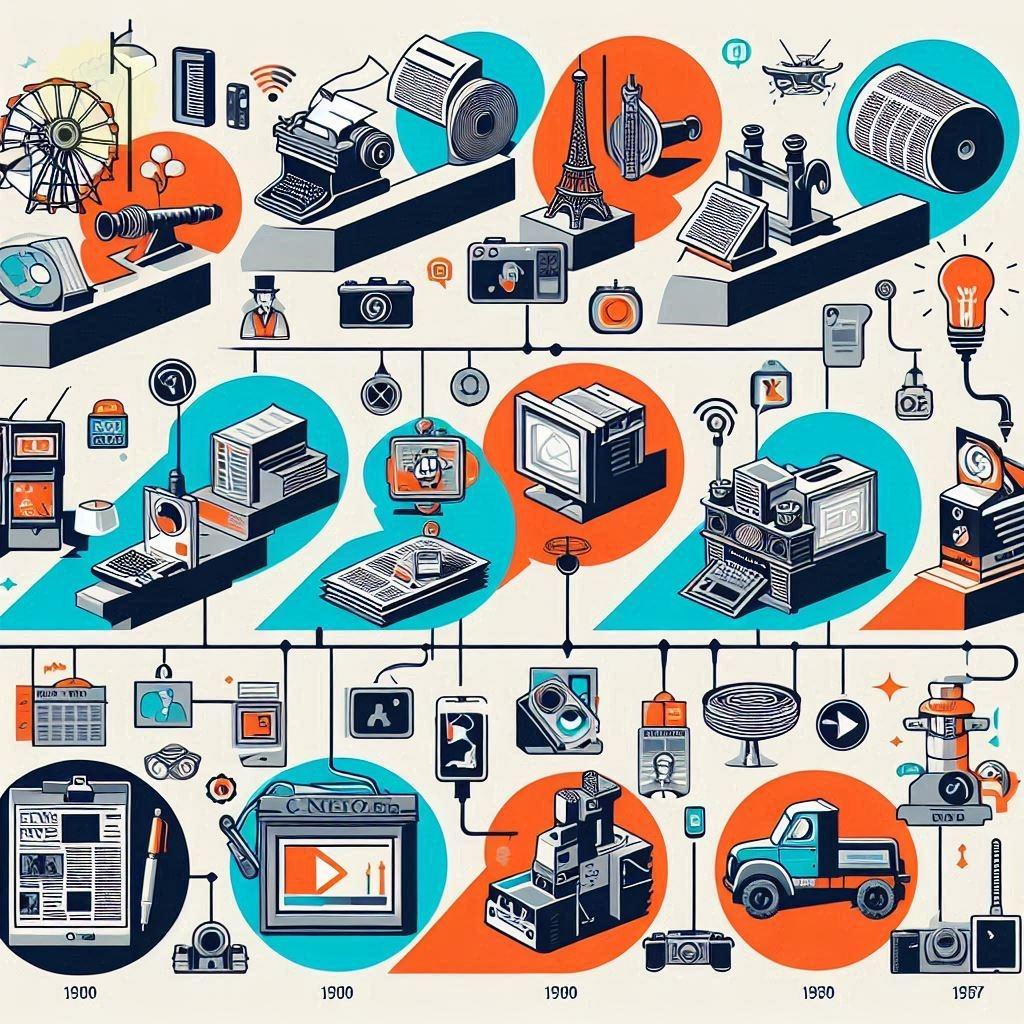The Evolution of News Consumption
Over the years, the way audiences consume news has undergone significant transformations. The transition from print to digital media, along with the rise of new formats like podcasts and video journalism, has reshaped not only how information is disseminated but also how audiences engage with news.
Shift from Print to Digital
1. Historical Context: In the past, print media—newspapers and magazines—was the primary source of news. People relied on physical copies delivered to their doorsteps or purchased at newsstands. The traditional model revolved around scheduled publication cycles, typically daily or weekly.
2. Advent of the Internet: The rise of the internet in the late 20th century marked a turning point in news consumption. With instant access to information online, audiences began to shift away from print. Websites became news portals, allowing readers to access stories at their convenience.
3. Mobile Revolution: The proliferation of smartphones further accelerated this transition. News apps and social media platforms allowed users to consume news anytime, anywhere. Notifications and real-time updates became the norm, leading to a more immediate engagement with current events.
4. Audience Preferences: Research indicates that younger audiences, in particular, prefer digital platforms for news consumption. They favor quick, digestible content that fits into their fast-paced lifestyles. This shift has led traditional media outlets to adapt their strategies to attract these audiences, often by developing their online presence and engaging with audiences through social media.
Rise of Podcasting
1. Growing Popularity: Podcasts have seen a meteoric rise in popularity in the last decade. With their on-demand nature, podcasts allow listeners to consume news while multitasking—during commutes, workouts, or household chores. This flexibility has attracted a diverse audience looking for convenience.
2. Diverse Content: The podcasting landscape is incredibly diverse, with shows covering a wide array of topics, including politics, social issues, and investigative journalism. This variety appeals to niche audiences, allowing listeners to choose content that resonates with their interests.
3. Intimacy and Engagement: The format of podcasting fosters a sense of intimacy and connection between hosts and listeners. The conversational style and storytelling techniques used in many podcasts engage audiences on a personal level, making news feel more relatable and accessible.
4. Influence on Journalism: Many traditional news organizations have launched their own podcasts, blending journalistic integrity with the engaging storytelling style characteristic of the medium. This trend has created a hybrid approach to news consumption, where audio storytelling complements written articles and broadcasts.
Rise of Video Journalism
1. Visual Appeal: Video journalism has gained traction as audiences increasingly prefer visual content. Platforms like YouTube, social media, and news apps now prioritize video stories, catering to the preference for visual learning and engagement.
2. Real-Time Coverage: Live video broadcasts and on-the-scene reporting have become crucial in breaking news scenarios. The immediacy of video allows audiences to witness events as they unfold, providing a sense of being part of the action and enhancing the emotional impact of news stories.
3. Short-Form Content: With the rise of platforms like TikTok and Instagram, short-form video content has emerged as a popular way to consume news. Brief, engaging clips can deliver key information quickly, appealing to audiences with limited attention spans.
Multi-Platform Strategy: Many news organizations now employ a multi-platform strategy, using videos to complement articles and social media posts. This approach maximizes audience reach and engagement, allowing audiences to interact with news content in ways that suit their preferences.
# Bharat Aawaz
Over the years, the way audiences consume news has undergone significant transformations. The transition from print to digital media, along with the rise of new formats like podcasts and video journalism, has reshaped not only how information is disseminated but also how audiences engage with news.
Shift from Print to Digital
1. Historical Context: In the past, print media—newspapers and magazines—was the primary source of news. People relied on physical copies delivered to their doorsteps or purchased at newsstands. The traditional model revolved around scheduled publication cycles, typically daily or weekly.
2. Advent of the Internet: The rise of the internet in the late 20th century marked a turning point in news consumption. With instant access to information online, audiences began to shift away from print. Websites became news portals, allowing readers to access stories at their convenience.
3. Mobile Revolution: The proliferation of smartphones further accelerated this transition. News apps and social media platforms allowed users to consume news anytime, anywhere. Notifications and real-time updates became the norm, leading to a more immediate engagement with current events.
4. Audience Preferences: Research indicates that younger audiences, in particular, prefer digital platforms for news consumption. They favor quick, digestible content that fits into their fast-paced lifestyles. This shift has led traditional media outlets to adapt their strategies to attract these audiences, often by developing their online presence and engaging with audiences through social media.
Rise of Podcasting
1. Growing Popularity: Podcasts have seen a meteoric rise in popularity in the last decade. With their on-demand nature, podcasts allow listeners to consume news while multitasking—during commutes, workouts, or household chores. This flexibility has attracted a diverse audience looking for convenience.
2. Diverse Content: The podcasting landscape is incredibly diverse, with shows covering a wide array of topics, including politics, social issues, and investigative journalism. This variety appeals to niche audiences, allowing listeners to choose content that resonates with their interests.
3. Intimacy and Engagement: The format of podcasting fosters a sense of intimacy and connection between hosts and listeners. The conversational style and storytelling techniques used in many podcasts engage audiences on a personal level, making news feel more relatable and accessible.
4. Influence on Journalism: Many traditional news organizations have launched their own podcasts, blending journalistic integrity with the engaging storytelling style characteristic of the medium. This trend has created a hybrid approach to news consumption, where audio storytelling complements written articles and broadcasts.
Rise of Video Journalism
1. Visual Appeal: Video journalism has gained traction as audiences increasingly prefer visual content. Platforms like YouTube, social media, and news apps now prioritize video stories, catering to the preference for visual learning and engagement.
2. Real-Time Coverage: Live video broadcasts and on-the-scene reporting have become crucial in breaking news scenarios. The immediacy of video allows audiences to witness events as they unfold, providing a sense of being part of the action and enhancing the emotional impact of news stories.
3. Short-Form Content: With the rise of platforms like TikTok and Instagram, short-form video content has emerged as a popular way to consume news. Brief, engaging clips can deliver key information quickly, appealing to audiences with limited attention spans.
Multi-Platform Strategy: Many news organizations now employ a multi-platform strategy, using videos to complement articles and social media posts. This approach maximizes audience reach and engagement, allowing audiences to interact with news content in ways that suit their preferences.
# Bharat Aawaz
The Evolution of News Consumption
Over the years, the way audiences consume news has undergone significant transformations. The transition from print to digital media, along with the rise of new formats like podcasts and video journalism, has reshaped not only how information is disseminated but also how audiences engage with news.
Shift from Print to Digital
1. Historical Context: In the past, print media—newspapers and magazines—was the primary source of news. People relied on physical copies delivered to their doorsteps or purchased at newsstands. The traditional model revolved around scheduled publication cycles, typically daily or weekly.
2. Advent of the Internet: The rise of the internet in the late 20th century marked a turning point in news consumption. With instant access to information online, audiences began to shift away from print. Websites became news portals, allowing readers to access stories at their convenience.
3. Mobile Revolution: The proliferation of smartphones further accelerated this transition. News apps and social media platforms allowed users to consume news anytime, anywhere. Notifications and real-time updates became the norm, leading to a more immediate engagement with current events.
4. Audience Preferences: Research indicates that younger audiences, in particular, prefer digital platforms for news consumption. They favor quick, digestible content that fits into their fast-paced lifestyles. This shift has led traditional media outlets to adapt their strategies to attract these audiences, often by developing their online presence and engaging with audiences through social media.
Rise of Podcasting
1. Growing Popularity: Podcasts have seen a meteoric rise in popularity in the last decade. With their on-demand nature, podcasts allow listeners to consume news while multitasking—during commutes, workouts, or household chores. This flexibility has attracted a diverse audience looking for convenience.
2. Diverse Content: The podcasting landscape is incredibly diverse, with shows covering a wide array of topics, including politics, social issues, and investigative journalism. This variety appeals to niche audiences, allowing listeners to choose content that resonates with their interests.
3. Intimacy and Engagement: The format of podcasting fosters a sense of intimacy and connection between hosts and listeners. The conversational style and storytelling techniques used in many podcasts engage audiences on a personal level, making news feel more relatable and accessible.
4. Influence on Journalism: Many traditional news organizations have launched their own podcasts, blending journalistic integrity with the engaging storytelling style characteristic of the medium. This trend has created a hybrid approach to news consumption, where audio storytelling complements written articles and broadcasts.
Rise of Video Journalism
1. Visual Appeal: Video journalism has gained traction as audiences increasingly prefer visual content. Platforms like YouTube, social media, and news apps now prioritize video stories, catering to the preference for visual learning and engagement.
2. Real-Time Coverage: Live video broadcasts and on-the-scene reporting have become crucial in breaking news scenarios. The immediacy of video allows audiences to witness events as they unfold, providing a sense of being part of the action and enhancing the emotional impact of news stories.
3. Short-Form Content: With the rise of platforms like TikTok and Instagram, short-form video content has emerged as a popular way to consume news. Brief, engaging clips can deliver key information quickly, appealing to audiences with limited attention spans.
Multi-Platform Strategy: Many news organizations now employ a multi-platform strategy, using videos to complement articles and social media posts. This approach maximizes audience reach and engagement, allowing audiences to interact with news content in ways that suit their preferences.
# Bharat Aawaz
0 Comments
0 Shares
3K Views
0 Reviews




